人教版新目标七年级下册英语全册教案(新)教学内容
- 格式:doc
- 大小:335.00 KB
- 文档页数:101
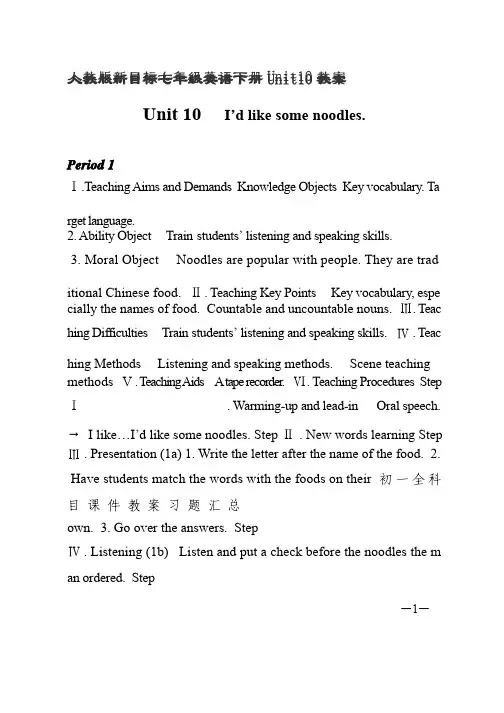
—1—人教版新目标七年级英语下册Unit10教案Unit 10I’d like some noodles.Period 1 Ⅰ.Teaching Aims and Demands Knowledge Objects Key vocabulary. Ta rget language. 2. Ability Object Train 2. Ability Object Train students’students’students’ listening and speaking skills. listening and speaking skills.3. Moral Object Noodles are popular with people. They are trad itional Chinese food. Ⅱ. Teaching Key Points Key vocabulary, espe cially the names of food. Countable and uncountable nouns. Ⅲ. Teac hing Difficulties Train hing Difficulties Train students’students’students’ listening and speaking skills. listening and speaking skills. Ⅳ. Teac hing Methods Listening and speaking methods. Scene teaching methods Ⅴ. T eaching Aids A tape recorder . Ⅵ. Teaching Procedures Step Ⅰ. Warming-up and lead-in Oral speech.→ I like I like…I’…I’…I’d like some noodles. Step d like some noodles. Step Ⅱ. New words learning Step Ⅲ. Presentation (1a) 1. Write the letter after the name of the food. 2. Have students match the words with the foods on their 初一全科目课件教案习题汇总语文数学英语历史地理own. 3. Go over the answers. StepⅣ. Listening (1b) Listen and put a check before the noodles the m an ordered. StepⅤ. Pairwork(1c) Ask students to practice similar conversation s in pairs. Students take turns to be the customer and the noodles ma ker . StepⅥ. Summary and homework Remember the words and practice the target language.Period 2Ⅰ.Teaching Aims and Demands 1. Knowledge Objects Target language Ability Object Train Ability Object Train students’students’students’ listening and speaking skills. Train stude listening and speaking skills. Train stude nts’nts’ communicative competence. Moral Object Noodles are popular communicative competence. Moral Object Noodles are popular with people. They are traditional Chinese food. Ⅱ. Teaching Key Poi nts T h e t a r g e t l a n g u a g e u s e d f o r a s k f o r a n d g i v e p e r s o n a l information. Order food. Ⅲ. Teaching Difficulties Train Train students’students’students’ listening and speaking skills. Train listening and speaking skills. Train listening and speaking skills. Train students’students’students’ commu commu nicative competence. Ⅳ. Teaching Methods Listening and speaking methods. Scene teaching methods Ⅴ. T eaching Aids A tape recorder Ⅵ. Teaching Procedures Step Ⅰ. Warming-up and revision Oral speech and free talk. StepⅡ. Listening (2a 2b) 1. . Listening (2a 2b) 1. YY o u ’r e t o listen and check the names of the foods you hear on the tape. 2. Play the recording twice. Then che ck the answers. 3. P lay th e s ame record ing ag ain. Lis t en carefully and fill in the blanks. StepⅢ. Pairwork (2c,2d) 1. Work with a partner. One is a customer and t he other is a waiter. 2. Invite several pairs of students to act out the ir conversations in front of the class. 3.Have some students role-p lay the conversations in pairs,then explain it to the class. StepⅣ. Grammar Focus G u i d et h e s t u d e n t s t o m a k e s o m e s e n t e n c e s w i t h I ’d , H e ’d and and They’d.They’d.They’d. Step StepⅤ. Conversation practice (3a ,3b) 1. You are to match each question wi th an answer. 2. Get students to do the task in pairs. 3. Put students i nto pairs. One is working in a noodles h o u s e. T h e o t h e r i s t h e c u s t o m e r. G e t t h e p a i r s t o s t a r t t h e activity . Ste pⅥ. Summary and homework 1. S u m m a r yt h e t a r g e t l a n g u a g e w e ’v e l e a r n e d i n t h i s class. 2. Reread the conversa tion in 3a. try to recite it. 3. Write down the conversation in 3c.Period 3Ⅰ. T . Teaching Aims and Demands Knowledge Objects Key vocabulary eaching Aims and Demands Knowledge Objects Key vocabulary . T . Tar ar get language. 2. Ability Object Train get language. 2. Ability Object Train students’students’ listening and speaking skill s. Train s. Train students’students’students’ communicative competence. 3. Moral Object Every communicative competence. 3. Moral Object Every one should choose foods which are good for h is health. Ⅱ. T eachi ng Key Points Learn how to ask for and give personal information an d write down the information. Ⅲ. Teaching Difficulties Learn howto ask for and give personal information and write down the i nformation. Ⅳ. Teaching Methods Practicing methods. Scene teach ing methods Ⅴ. T eaching A ids A tape recorder Ⅵ. Teaching Procedures StepⅠ.Warming-up and lead-in Oral speech. Describe one .Warming-up and lead-in Oral speech. Describe one’’s preferenc es. StepⅡ. New words learning. Porridge onion fish pancake Step Ⅲ. Presentation (1a 1b) 1. Match the words with the pictures. Write the letter of the food on the blank line before its name.2. Circle the things you like in the picture. And make an “×”“×” nex nex t to the things you t to the things you don’t don’t don’t like. Step like. StepⅣ. Listening (1c,1d) 1. Listen carefully and circle in activity 1a th e words that you hear on the tape. 2. Play the same recording again. W Write down the rite down the rite down the customer’s customer’s customer’s address, telephone number and what he or address, telephone number and what he or ders. 3.Check the answers. StepⅤ. Pairwork (2a) 1. Put students into pairs. Ask questions abo ut what they door eat on their birthdays. 2. Invite more advanced students t o demonstrate how to do the activity o demonstrate how to do the activity. Step . StepⅥ.Summary and homework Remember the key words and target la nguage.Period 4Ⅰ. T . Teaching Aims and Demands Knowledge Objects Learn to read and eaching Aims and Demands Knowledge Objects Learn to read and write an ad for House of Dumplings. 2. Ability Object Train student s’s’ reading and writing skills. Train reading and writing skills. Train reading and writing skills. Train students’students’students’ integrating skills. 3. Moral integrating skills. 3. Moral Object Keep healthy. Ⅱ. Teaching Key Points Learn how to order fo od. Learn to write an ad for House of Dumplings. Ⅲ. T . Teaching Diffic eaching Diffic ulties Learn how to order food. Learn to write an ad for House of D umplings. Ⅳ. Teaching Methods reading and writing methods. Practi cing methods Ⅴ. T eaching A ids A tape recorder Ⅵ. Teaching Procedure s Step I. Warming-up and revision Oral speech and dictation. Step II.R eading and answering(2b,2c) Do 2b:Ask students to read the article and complete the c h a r t ,t h e n c h e c k t h e a n s w e r s.E x p l a i n t h e k e y p o i n t s t o the class. D o 2c :H a v e s t u d e n t s r e a d t h e a r t i c l e a g a i n a n d a n s w e r t h e questions,then check the answers. Step III. Reading (3a) Fill in the blank lines, usi ng words from the box. Get students to complete the paragraph on t heir own. Step IV . Writing (3b,3c) 1. W r i t e y o u r o w n a d. P l e a s e u s e t h e a d i n a c t i v i t y 3a a s a model. 2. Us e the sample version in activity 1c to demonstrate how to order a meal. 3.Have some students to read their ads to the class. Step V . P airwork Let students work in pairs to order meal. Students p ractice both roles. Step VI. Summary and homework Order food.Period 5Ⅰ. T . Teaching Aims and Demands Knowledge Objects Reaching Aims and Demands Knowledge Objects R e v i e w t h e n a me s o f f o o d s a n d d r i n k s , t h e t a rg e t l a n g u a g e used to order food, ask for and give personal information and design an ad.2. Ability Object Train 2. Ability Object Train students’students’students’ communicative competence.3. Moral communicative competence. 3. Moral Object Noodles, a kind of fast food, helps save a lot of time. And it ’s ’s delicious and rich in nutrient, thank the inventor. Ask your family delicious and rich in nutrient, thank the inventor. Ask your family members or classmates what they’d they’d like to eat. In this way, you like to eat. In this way, you will understand each other better. Ⅱ. Teaching Key Points Review all the key words and order food. Review to ask for and give person al information. Ⅲ. Teaching Difficulties Order food, design an ad fo r House of Dumplings. Ⅳ. Teaching Methods Practicing methods. Ⅴ. T eaching A ids Ⅵ. Teaching Procedures Step Ⅰ.W arming-up Step Ⅱ. Review the key vocabulary Give students several minutes to me morize the key vocabulary . Large, medium, noodles, beef, mutton, chic ken, cabbage, potatoes, tomatoes, dumplings, soup, green tea, orang e juice. StepⅢ. Self Checks1, 2 ,3 D oS e l f C h e c k 1. A s k s t u d e n t st o c h e c k a l l t h e w o r d s t h e y know. Write five new word s in their V ocab-builder. Do Self Check2. Ask students to complete th—7—e task,then h a v e s o me s t u d en ts r e a d th e 3 co n v e r s at io n s t o t h e c l as s i n pairs. D o S e l f C h e c k 3. A s k s t u d e n t s t o w r i t e a c o n v e r s a t i o n w i t h the help of the clues in pairs,t hen have some pairs read their conversations to the class. StepⅣ. Review the target language Make a conversation use the target la nguage. What kind of noodles would you like?→I’d I’d like beef noodles. What size bowl of noodles would you like? like beef noodles. What size bowl of noodles would you like?→I’d I’d like a small/medium/large bowl of noodles. like a small/medium/large bowl of noodles. like a small/medium/large bowl of noodles. What’s What’s What’s your address? your address? →My address is My address is ….….…. Get several pairs of students to act out their conv Get several pairs of students to act out their conv ersations. StepⅤ.Summary and homework Summary the language .Summary and homework Summary the language we’ve we’ve we’ve learned learned in this unit. Finish 3c as your homework.。
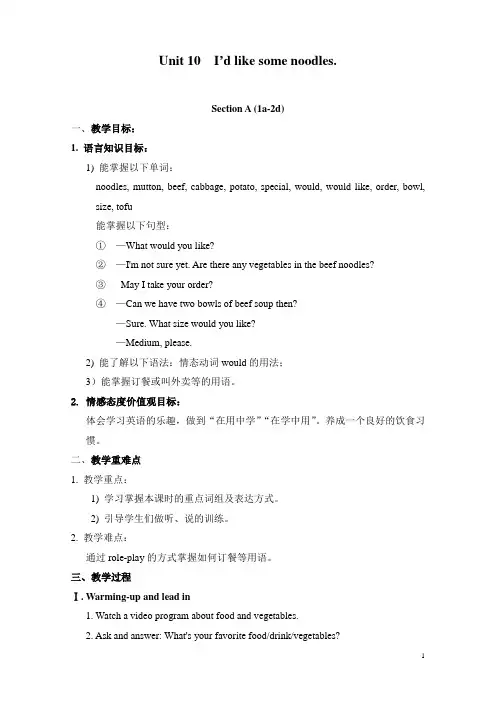
Unit 10 I’d like some noodles.Section A (1a-2d)一、教学目标:1. 语言知识目标:1) 能掌握以下单词:noodles, mutton, beef, cabbage, potato, special, would, would like, order, bowl, size, tofu能掌握以下句型:①—What would you like?②—I'm not sure yet. Are there any vegetables in the beef noodles?③May I take your order?④—Can we have two bowls of beef soup then?—Sure. What size would you like?—Medium, please.2) 能了解以下语法:情态动词would的用法;3)能掌握订餐或叫外卖等的用语。
2. 情感态度价值观目标:体会学习英语的乐趣,做到“在用中学”“在学中用”。
养成一个良好的饮食习惯。
二、教学重难点1. 教学重点:1) 学习掌握本课时的重点词组及表达方式。
2) 引导学生们做听、说的训练。
2. 教学难点:通过role-play的方式掌握如何订餐等用语。
三、教学过程Ⅰ. Warming-up and lead in1. Watch a video program about food and vegetables.2. Ask and answer: What's your favorite food/drink/vegetables?Ⅱ. Presentation1. (show some pictures of food on the big screen)Present some new words and expressions to the Ss.2. Ss learn the new words and expressions by themselves and try to remember them.3. Work on 1a:Read the words on the left and look at the pictures on the right. Write the letters of the food on the line. Then check the answers.Ⅲ. Game (Guess the food.)(Show some pictures of food on the big screen)Let Ss guess what food it is.Ss try to guess the food and learn the words.Ⅳ. ListeningT: In the following conversation, one man is ordering some food. Now, let’s listen to the tape, find out the right noodles the person orders.Play the recording for the Ss to listen and check the answers.Ⅴ. Pair work1.Present the conversation in 1b on the big screen and ask Ss to practice it.2. Make their own conversations using the noodles in the picture.3. Let some pairs act out their conversations.Ⅵ. Listening1. Work on 2a;T: Now, look at the pictures on the right, listen to the conversations and check the names of the foods you hear.(Play the recording for the first time, students only listen carefully.Then, listen to the recording again, and check the names of the foods.Check the answers. )2. Work on 2b:(Play the recording for the Ss to listen and complete the sentences.)Play the recording twice. The first time Ss just listen. And the second time, Ss listen and write down the words.(If necessary, use the pause button to help Ss)3. Check the answers.Ⅶ. Pair work1. Ask and answer questions with your partner. Use the information in 2a.2. Show the conversations of 2a on the big screen to the Ss.3. Make a model for the Ss.T: What kind of noodles would you like?S1: I'd like beef noodles, please.…3. Ss work in pairs and practice the conversations.Ⅷ. Role-play1. Ask Ss to read the conversation in 2d and find the answer to this question:What would they like?(They would like one large bowl of beef soup, one gongbao chicken, and one mapo tofu with rice.)2. Check the answers with the Ss.3. Ss work with their partners and role-play the conversation.VIII. Language pointsIX. ExercisesHomework1. Review the words and expressions in this period.2. Role-play the conversation in 2d.3. Write a short conversation to order some noodles you like in a restaurant.板书设计:Section A (Grammar Focus-3c)一、教学目标:1. 语言知识目标:1) 继续练习运用如何订餐或叫外卖等的用语。
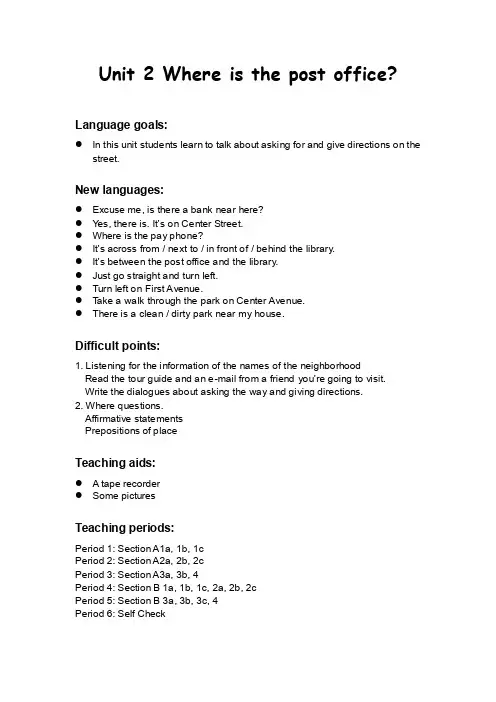
Unit 2 Where is the post office?Language goals:●In this unit students learn to talk about asking for and give directions on thestreet.New languages:●Excuse me, is there a bank near here?●Y es, there is. It’s on Center Street.●Where is the pay phone?●It’s across from / next to / in front of / behind the library.●It’s between the post office and the library.●Just go straight and turn left.●Turn left on First Avenue.●T ake a walk through the park on Center Avenue.●There is a clean / dirty park near my house.Difficult points:1. Listening for the information of the names of the neighborhoodRead the tour guide and an e-mail from a friend you’re going to visit.Write the dialogues about asking the way and giving directions.2. Where questions.Affirmative statementsPrepositions of placeTeaching aids:● A tape recorder●Some picturesTeaching periods:Period 1: Section A1a, 1b, 1cPeriod 2: Section A2a, 2b, 2cPeriod 3: Section A3a, 3b, 4Period 4: Section B 1a, 1b, 1c, 2a, 2b, 2cPeriod 5: Section B 3a, 3b, 3c, 4Period 6: Self CheckTeaching aims:1. T each vocabulary words.2. T arget languages: Is there a bank near here? Y es, there is. It’s on CenterStreet.3. Enable the students to ask for and give directions on the street.4. Help the students to ask for and give directions on the street.Teaching procedures:Step 1. Warming upShow three pictures prepared before class to the students. There is acat in a box in picture 1. There is a cat on a box in picture 2. There is acat under the box in picture 3.Then ask some students to ask and answer these questions.Step 2.Match work (2a)Ask the students to read the picture and the words in the numbered list.Ask the students to match each word or phrase on the list with one of the pictures.Then check the answers.Present the new sentence patterns.Then ask the students to read the dialogue in the picture.Step 3. Listening (1b)Ask the students to listen to the conversations and circle the places in 1a.Change the roles and do the same again.Then students ask and answer without the help of the recording.Step 4. PracticePoint to the different locations shown in the picture. Ask different students to name each one.Then point to more locations and let the students to practice more.Homework1. Practice the conversation in the picture on page 7.2. Learn the new words and phrases in this period by heart.Teaching aims:1. Learn the vocabulary words and useful expressions.2. T arget languages:The pay phone is across from the library.The pay phone is next to the library.The pay phone is between the post office and the library.The pay phone is on Greet Street.The pay phone is in front of the library.The pay phone is behind the library.3. Enable the students to talk about the position of a place.4. Help the students to talk about the position of a place.Teaching procedures:Step 1. Revision and warming upCheck the homework by talking about the pictures on page 7 with thestudents or prepare some other pictures with different buildings in itand let the students practice asking and answering questions aboutthe places.Ask the students to practice more.Step 2. Presentation (2a)Introduce the items across from, next to, between, in front of, behindand on.Draw the following picture on the blackboard.Park 3 Centre StreetEncourage or help the students to answer: It’s across from the library.The same way goes with next to, on and in front of.Ask the students to match each sentence with one of the pictures.Then ask the students to read the six sentences and match thesentences the pictures.Check the answers.Step 3. Listening(2b)Review the buildings and street names in Activity 1a and the sixsentences in 2a.The read the six sentences in 2b to the class.Ask the students to listen to the recording and fill in the blanks.Play the tape. Check the answers.Step 4. Practice (2c)Ask the students to repeat the conversations after the recording.Ask the students to do the Pair work asking and answering questionsabout the places in 1a.Step 5.Grammar FocusAsk the students to read the sentences in the grammar box aloud. Theask them to answer the following questions. Explain some languagepoints if t he students can’t understand.HomeworkAsk the students to practice talking about their neighborhood in pairs.Period 3T eaching aims:1. T each vocabulary words.2. T arget languages:Just go straight and turn left.It’s down Bridge Street on the right.It’s next to a supermarket.3. Enable the students to talk about the neighborhood.4. Help the students to talk about the neighborhood.Teaching procedures:Step 1. RevisionLet the students look at the picture in activity 1a. And ask somestudents to answer some questions in order to check the homework.Say, Is there a library near here? Where is it? Is there a bank near here?Where is it?Put up the picture of activity 2a on the blackboard and ask them tomake conversations.Step 2. Presentation (3a)Guide the students to guess the meanings of the three traffic signs.Show the pictures and ask some questions about the pictures.Then ask the students to hold up their left hands and then their righthands to practice “left” and “right”.Point to the picture and let the students read the conversation.Ask the students to read the conversations. Then ask them to find Pauland Nancy in the picture.Ask the students to role play the conversation then point out the placethat Paul wants to get to.Step 3. Complete the conversations (3b)Ask the students to make conversations and answer the questionsbelow each picture.The students point out the place in the picture. And write down theanswers on the line in the pictures. Or ask a pair of students to say theconversation, the others point to the speakers’ place.Step 4. GameAsk the students to look at the picture in Activity 1a and name all the buildings.Ask some students to read the conversation in the picture in Activity 4.And then explain the instruction to the student.Then ask some groups to present their work.HomeworkAsk the students to make a similar conversation to that in Activity 3a. Period 4Teaching aims:1. T each vocabulary words.2. T arget languages:Is there a big supermarket near your house?Y es, there is.There is a big supermarket.No! There is a small supermarket.3. Enable the students to describe the neighborhood.4. Help the students to describe the neighborhood.Teaching procedures:Step 1. RevisionCheck the homework by asking the following questions.Say, Look at the picture in activity 3a. Suppose you are standing nearthe building on the side of New Street. Please answer my questions.Excuse me. Is there a pay phone in the neighborhood?Ask another student to answer questions.Give more students chances to practice this dialogue.Step 2.Match work (1a)Bring in some objects or pictures to the students. (Two rulers, one is old,the other is new. Two boxes, one is big and the other is small. Two bottles, one is clean and the other is dirty. Two pictures of a street, one is busy and the other is quiet.)Say, Look at the rulers, please. Can you find the difference between them? Y es. This one is old. (Show the old ruler.) And this one is new.(Show the new ruler.) Do you understand old and new?Ask the students to talk about the picture.Point to each half of each picture and ask about the difference between the halves.Go on with the other pictures to teach the language items.Ask the students to match the words with the pictures.Step 3. Pair workCall attention to the conversation in the picture.Then ask the students to work in pairs and take turns asking each other questions about the things on the list of phrases in activity 1a on page 7. Step 4. Listening (2a, 2b)Ask the students to listen to the tape and circle the places in 1a.Say: Now please listen to the tape again. Listen to it and draw the places in Michael’s neighborhood on the street map. Just listen.Play the recording.Play the recording again.Then have some students show their completed drawing to the class. Step 5. Pair workAsk the students to work in pairs talking about drawings to the class.Then ask some pairs to present their dialogues to the class.Ask the students to work in pairs, draw a map of their own neighborhood and practice asking and answering questions about the places they live in.HomeworkAsk the students to make similar conversations to that in Activity 1b.Period 5Teaching aims:1. T each vocabulary words.2. T arget languages:Turn left on First Avenue and enjoy the city’s quiet streets and small parks.T ake a walk through the park on Center Avenue.This is the beginning of the garden tour.Bridge is a good place to have fun.3. Enable the students to write a tour guide and draw the rout to somewhere.4. How to write a tour guide and draw the rout to somewhere.Teaching procedures:Step 1. RevisionCheck the homework by asking about the student’s neighborhood.Ask the students to work in pairs.Ask the students to work in pairs.Then ask some pairs to present their conversations to the whole class.Step 2. Reading (3a, 3b)Ask the students to read the tour guide.Divide the whole class into four groups to have a quiz.T ell the students to keep these words down and make at least two sentences with each word after class.After that ask the students to look at the pictures and fill in the blanks for this tour guide.Step 3.WritingAsk the students to write a tour guide with the students.Names of buildings and locations.Description wordsWords that talk about positions.Words that talk about directions.Step 4. Pair work (4b)Learn to draw a picture of neighborhood. First ask the students toanswer the questions according to the pictures.Then ask the students to draw a picture according to the followingconversation.Then ask students to present their drawings to the whole class.Homework1. Ask the students to talk about the street and buildings in their ownneighborhood.2. Ask the students to make sentences with the description words they keptdown in the class.Period 6Teaching aims1. T each vocabulary words.2. T arget languages:I know you are arriving next Sunday.Let me tell you the way to my house.I hope you have a good trip.3. Enable the students to write about the neighborhood.4. Help the students to learn how to write about the neighborhood.Teaching procedures:Step 1. RevisionCheck the homework by asking and answering some questions.Give more students chances to practice.Step 2.Key word check(1)Ask the students to check the words they know.Then ask the students to do the some exercises.Step 3.Vocab-Builders (2)Expand the students’ vocabulary.After that ask the students to share their list with other students.Step 4. ReadingAsk the students to read the letter and draw the rout on the map.Ask the students to change the letter into a telephone conversation.Let the students pay attention to the pictures.Say, Look at the picture of Sally. How old do you think she is? Where do you think she is from? What language do you think she speaks? What do you think she likes?What do you think she dislikes?The same step goes with Jim and Julie.After a few minutes, ask some students to read their descriptions to the class.Step 5. Just for Fun!Call attention to the conversation in the cartoons.Ask the students to read the conversation and then answer the questions.HomeworkAsk the students to do the following:1. Suppose your friend is going to visit you. He doesn’t know the way toyour house. Write a letter to him to tell him the route from the bus stop to your house.2. Review the next unit.。
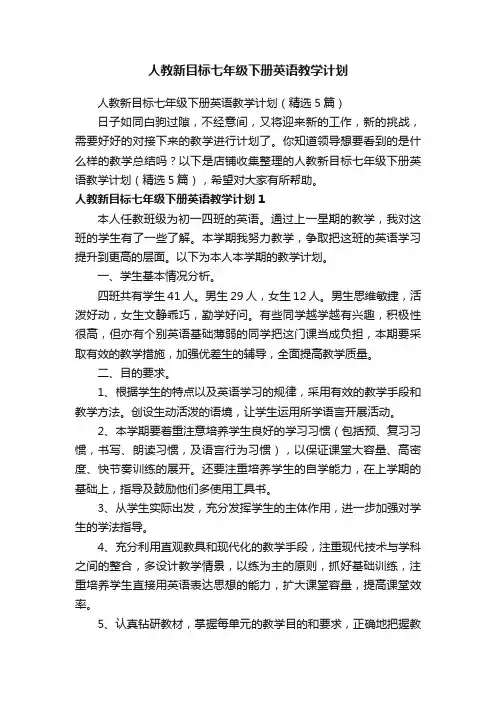
人教新目标七年级下册英语教学计划人教新目标七年级下册英语教学计划(精选5篇)日子如同白驹过隙,不经意间,又将迎来新的工作,新的挑战,需要好好的对接下来的教学进行计划了。
你知道领导想要看到的是什么样的教学总结吗?以下是店铺收集整理的人教新目标七年级下册英语教学计划(精选5篇),希望对大家有所帮助。
人教新目标七年级下册英语教学计划1本人任教班级为初一四班的英语。
通过上一星期的教学,我对这班的学生有了一些了解。
本学期我努力教学,争取把这班的英语学习提升到更高的层面。
以下为本人本学期的教学计划。
一、学生基本情况分析。
四班共有学生41人。
男生29人,女生12人。
男生思维敏捷,活泼好动,女生文静乖巧,勤学好问。
有些同学越学越有兴趣,积极性很高,但亦有个别英语基础薄弱的同学把这门课当成负担,本期要采取有效的教学措施,加强优差生的辅导,全面提高教学质量。
二、目的要求。
1、根据学生的特点以及英语学习的规律,采用有效的教学手段和教学方法。
创设生动活泼的语境,让学生运用所学语言开展活动。
2、本学期要着重注意培养学生良好的学习习惯(包括预、复习习惯,书写、朗读习惯,及语言行为习惯),以保证课堂大容量、高密度、快节奏训练的展开。
还要注重培养学生的自学能力,在上学期的基础上,指导及鼓励他们多使用工具书。
3、从学生实际出发,充分发挥学生的主体作用,进一步加强对学生的学法指导。
4、充分利用直观教具和现代化的教学手段,注重现代技术与学科之间的整合,多设计教学情景,以练为主的原则,抓好基础训练,注重培养学生直接用英语表达思想的能力,扩大课堂容量,提高课堂效率。
5、认真钻研教材,掌握每单元的教学目的和要求,正确地把握教材的重点和难点,根据的学生年龄特点及班级的实际情况,精心设计教学程序,选择适当的教学方法,写出各单元中的每课教案。
三、具体措施总原则:提高课堂利用率,有效利用课堂时间。
尽可能地挖掘优等生的潜力,促使其提高。
对于成绩较弱者,针对性地进行帮补,并通过优等生的帮助促其进步。

2016年春七年级英语下册Unit1-10全册教案Unit 1 Can you play the guitar? (2)Unit 2 What time do you go to school? (11)Unit3 How do you get to school ? (19)Uni t4 Don’t eat in class. (25)Unit5 Why do you like pandas? (33)Unit 6 I’m watching TV (43)Unit 7 It’s raining! (55)Unit 8 Is there a post office near here? (65)Unit 9 What does he look like? (73)Unit 10 I’d like some noodles (84)Unit 11 How was your school trip? (91)Unit 12 What did you do last weekend? (103)2016年春七年级英语下册教案Unit 1 Can you play the guitar?一. Knowledge and abilities goals:1.vocabulary:dance,swim,sing,play chess , paint ,speak English, play the guitar2. How to use Mode l verb” can”.3. Listening and speaking skills and communicative competence.二. Teaching method: Listening and speaking methods. Pair works.三. Moral goals: Encourage students to express their abilities.Content of courses: In this period, students will learn some names of clubs ,such as art , music, chess club, swimming club, etc. students will learn the drills :Do you want to join…club ?Can you …?四. Importance and difficulty: canTeaching Aids: A tape recorder. Some pictures. A projector Some sports things, such as volleyball, basketball, etc. Preparation test paper for lessons before class.五. Teaching Time: 4 periodsPeriod 1 (Section A: 1a-2d)授课人:______ 授课班级: _____ 授课时间:2016年___月___日____午第____节1.Knowledge Objects: Learn to talk about abilities.Know something about the culture of clubs. Can you/he..?What can you do? What club do you want to join?can, can’t, draw, dance, swim, speak, walk.2.Teaching key point: can3. Teaching Difficult point: can4.Teaching Procedures:Step 1. Lead-inEnjoy a song I’m a musicianT: Do you want to be a musician? S:T: Can you play the piano? S…T: What can you do? S: I can…T: What about you? S:T: OK, now please show your talent and tell us what you can do.Ask one of the students come to the front and do the action. Ask other students to guess what he or she can do.Step 2. PresentationT: Look at the pictures. What are they doing? S:Step 3 Pair workLook at the pictures. Ask and answer like this:A: Can you play basketball?B: Yes, I c an. / No, I can’t.Can you…?Step 4 PresentationShow some pictures of famous stars. Practice the third person “he, she, they”T: Where can you play chess? S:T: Yes, in a chess club. This term, we have a lot of clubs. What club do you want to join? S…T: Sounds great. Can you…?S: Yes, I can/ No, I can’tIf the answer is negative, guide students to say:S: No, I can’t. But I can learn it from others.Step5 Pair workA: What club do you want to join?B: I want to join the…A: Can you …?B: Yes, I can . No, I can’t. But I can learn it from others.Step 6 ListeningListen to 1bListen to 2a and 2b. Tell them to give special attention to listening activity (names of the clubs). Finish the tasks.Step 7 Pair workLook at 2b and talk about what the people can do the clubs they want to join.Step 7 Role-play the conversation 2dT: If you like telling stories. What club can you join?S: Story telling club.T: Right. Please read the conversation following the recording. Who wants to join the story telling club? Then role-play the conversation.Step 8 Explain some language points.Step 9 HomeworkReflection after class:_____________________________________________________________________ _____________________________________________________________________ _____________________________________________________________________ _________________________________Period 2 (Section A: 3a-3c)授课人:______ 授课班级: _____ 授课时间:2016年___月___日____午第____节1. Knowledge Objects: go on learning to talk about abilities.—Can you play the guitar? —Yes, I can./ No, I can't.—What can you do? —I can dance.—What club do you want to join? —I want to join the chess club.2. Teaching key points: Conclude the usage of ‘can’; put all new language into practice through different activities.3. Teaching Difficult points: Distinguish “say, speak, tell, talk”4.Teaching Procedures:Step1:Greeting, Warming up and duty report.Watch a flash about the content of the Just for fun.Talk something about the flash: Why is the other boy unhappy?Introduce because of the difference of time zones, the time in different places are different.Revision: show the time in six places: Beijing, Tokyo, Paris, Los Angeles, New York, and London. Elicit the sentence pattern: What time is it?It’s……Draw attention to the “am” and “pm”. For instance, Beijing is seven o’clock in the morning. We can say Beijing is seven am. Los Angeles is three in the afternoon. So we can say Los Angeles is three pm. (teacher helps students answer).Step2:Review the words learnt in the last period and add more.(1)T:Here are some Chinese, let us see what time do they usually get up/ take a shower…get up take a shower eat breakfast go to school eat lunch run go homedo homework eat dinner go to bed(2)ask students to make a surveyAsk your friend 5 questions about his /her day. Then make a report.A: What time do you usually…?B: I usually…at…Step3:presentation.(1)Ben’s day. Introduce something about Ben.Using the sentence pattern: What time does he usually get up/go to school/…Pay attention to the verb form of the third person.Discuss Do you like ben’;s routines.(2)Show the picture of Scott. He usually gets up at 5 pm.Ask students to predict what his job is?(3)listen to the tape,and try to answer this question. then read through the passage,and match the pictures with the times.(4)read it again and fill in the chart.(5)answer the following questions1.Where does he work?2.How does he go to work?Step4:Work on 3a.(1)Read through the passage and tell me what his job is.(2)Read it again and match the pictures.(3)Answer questions:What does he do after he get up?Does he go to work after breakfast? What does he do?How does he go to work? By bus or on foot?What does he do before he goes to bed?What does“What a funny time to eat breakfast!”mean?Step5:Follow up.T:My friend Da Bao likes Scott's work, so he gets to Sai Te Hotel . But he doesn't find him.T: There are many children in the hotel. Look, they are coming. Please ask them questions to find the real Scott.Step6:Work on part4.T:Now six people make a group, and ask the other students when they usually go to bed . The leader lines up from the earliest to the latest bedtime.T: Let's listen Group1…Group2…Step7:Work on part 3 of self –check.T: Now I want to know something about what you do on weekends. You can go, ask your classmates and fill in the forms. Then you have a report.T: You may begin it like this "Ma Li gets up at …"Step8:Homework.Oral work:(1)Read 3a and recite it.(2)Go on making a survey to find out what your classmates do on weekends. Reflection after class:_____________________________________________________________________ _____________________________________________________________________ _____________________________________________________________________ _____________________________Period 3 (Section B: 1a-1f)授课人:______ 授课班级: _____ 授课时间:2016年___月___日____午第____节1. Knowledge Objects: go on learning to talk about abilities. drum, play the drum, piano, play the piano, violin, play the violin2. Teaching key points: Improve listening and speaking3. Teaching Difficult points: Improve listening and speaking4. Teaching Procedures:Step 1 Warming- up and revisionDaily greeting.Check the homework. Let some Ss report what his/her family members can do. Step 2 PresentationPlay the sound of different kinds of instruments. Let Ss guess what it is.Act and show your classmates your talent.T: Please stand in front of your classmates. Act and say what you can.S1: (sing and dance) I can sing and dance.S2: (play the drum) I can play the drum..Step 3 ListeningTell the Ss that they will listen to some sounds of the instruments. Listen and number the words [1-4] in the order of the sounds you hear in 1a.Play the recording again and check the answers.T: Now let's work on 1c. First, let one student read the words and phrases aloud. Then listen to the 1d and circle the words and phrase you hear.Check the answers:T: Now please look at the chart in 1e. What can Bill, Cindy and Frank do? What can't they do? You'll listen to the recording again. Then try to fill in the blanks.Step 4 Group workWork in groups. Take turn to talk about what Bill, Cindy and Frank can and can't do.S1: Bill can play the guitar, but he can't sing.S2: Cindy can sing and play the drum, but he can't play the piano.Teacher can walk around the classroom, and give some help to the Ss.Step 5 HomeworkMake up a conversation between a volunteer and a person who is in charge of a sports club/old people’s home/music club.Reflection after class:_____________________________________________________________________ _____________________________________________________________________ _____________________________________________________________________ ____________________________________Period 4 (Section B: 2a-self check)授课人:______ 授课班级: _____ 授课时间:2016年___月___日____午第____节1. Knowledge Objects: go on learning to talk about abilities. also, people, help (sb) with sth, center, home, today, be good with, make, make friends, weekend, on weekends/on the weekend, teach, musician2. Teaching key points: Also, too; be good with, help with3. Teaching Dif ficult points: Describe one’s ability4. Teaching Procedures:Step 1 Warming-upCheck the homeworkAsk some pairs to show their conversationsStep 2 ReadingFirst, show some pictures of the boys and girls and some key words in 2a.T: Here are some pictures and information about Peter, Alan and Ma Huan. Can you describe them according to the pictures and key words?S1: Guide Ss to use “also, too”, and distinguish how to use these two words.Give comments on Ss’ descriptions.T: Now we’ll read thre e ads. What's the main idea of each ad? What's each ad's title? Now let's read the three ads and select a title for each ad. Ss read carefully and try to select a title for each ad. Check the answers with the class.Step 3 Review the usage of “tell”,Re view and distinguish the usage and function of “help”T: Suppose Peter, Alan and Ma Huan want to help to do something after school. Which ad is right for him/her? Now read the descriptions in 2a and the ads in 2b again. Select a right ad for each person.Ss read the descriptions in 2a and the ads in 2b again. Try to select a right ad for each person. They can talk about the answers in their groups.Check the answers with the class.Step 4 Homework1. Recite 2a and 2b2. Finish the exercise on p6Reflection after class:____________________________________________________________________Unit 2 What time do you go to school?1. Teaching Aims:1) Aims of Basic Knowledge:①V ocabulary: time, shower, usually, O’clock, what time, go to schoo l, take ashower.②Grammar: What time do you…? What time does he / she…?③ Function: Use the simple tense to talk about the daily life.2) Aims of Abilities: Listening skill. Speaking skill. Reading skill. Writing skill.3) Aims of Emotion: Love life.2. Analysis of the Material:1) Brief Introduction of the teaching material:What time / When do you…?” “ What time / When does he…?”2) Teaching Focus: What time do you…? What time does he/ she…?3) Teaching Difficulties: Present tense.3. Learning Methods: Make a plan. Culture.4. Teaching Methods: Student- centered. Task-based Teaching.5. Teaching Time: 4 periodsPeriod 1(Section A: 1a-2a)授课人:______ 授课班级: _____ 授课时间:2016年___月___日____午第____节Step One: Warming-upGreetingT: Good afternoon, everyone.Ss: Good afternoon, Miss Yang.Step Two: Presentation1.Adjust the time, and ask students questions.T: What time is it? Ss: It’s 12 o’clock. ( Write on Bb )( Help Ss to say )T: What time is it? Ss: It’s 10:15.( Help Ss to say )2.Ask one student to come to the front, adjust the time and ask the otherstudents.S1: What time is it? Ss: It’s 9 o’clock.3.Teach the new words & phrases.Show some pictures of different clocks and the activities.T: I’m very busy these days. Can you guess what time I get up / eat breakfast / go to school / run / take a shower? ( Write on Bb)T: I usually get up at 6:35. ( Teach Ss the new word “ usually” )S1: You usually eat breakfast at …S2: You usually run at…S3: You usually take a shower at …4.Ask Ss to do the exercise of 1a, and then check the answers.Step Three: Listening1.Show Ss the timetable of Rick’s ( write on small Bb )Ask Ss listen to the recorder and fill in the chart.Then check the answers.2.Ask and answer.T: What time does Rick get up / eat breakfast / run / go to school / take a shower ?Ss: He gets up / eats breakfast / runs / goes to school / takes a shower at…( Ask Ss pay attention to the underlined phrases.)Step Four: Consolidation1.Ask Ss to look at the pictures and tell their days.Example: I usually get up at …. I eat breakfast at …. I go to s chool at …. At …, I takea shower.Step Six: Homework1.Try to remember all the words & phrases.2.Survey: Ask your classmates their routines, and give your report.3.Plan: January 1st is coming. Please plan it, and make your day wonderful.Step Seven Blackboard DesignReflection after class:_____________________________________________________________________ _____________________________________________________________________ _____________________________________________________________________ _______________________Period 2 (Section A: 2b-Grammar Focus)授课人:______ 授课班级: _____ 授课时间:2016年___月___日____午第____节1. Aims and demands :1) Language skills :Ss learn to talk about kinds of transportation, and how long it takes to go places, and how far apart places are.2) Target Language : Words : how far , get to , bicycle , subway , bus stop, train station , minute, kilometer, mile , transportation , calendarSentences: How do you get to school ? / How long does it take ? / How far is it ? 3) Moral object : Through learning this unit , Ss can enable them to care for each other whenever crossing the roads and pay attention to the sign of traffic.2. Analysis of the material:Students have learned the transportation before.. In this unit ,they need to learn more details about the transportation. At the same time ,they need to learn “How long and How far” and they can use them freely.3. Teaching methods:pairwork , groupwork ,listening and speaking, practicing4, learning strategies:Personalizing Inferring vocabulary5.Teaching aids:Tape recorder, a projector or a computer6.Teaching period:Four periods.Period 3 (Section B: 3a-3c)授课人:______ 授课班级: _____ 授课时间:2016年___月___日____午第____节1. Aims and Demands: Key vocabulary, How do you get to school ? How does he getto school ?2. Teaching methods : Listening Writing Pairwork3. Teaching Aids : A tape recorder.Step I Leading inT: Good morning, everyone! You know I live far away ,so I go to school by bus every day. What about you? David, “How often do you go to school?”S:--------T: So we will talk about how to get to places in this unit.Step IINow I will show you pic tures and let’s review the transportations we know. Then we will learn more about it .(take the subway) Please open your books and finish 1a. Step III1. There are five names in 1b.Now they are in the picture. We should find them.2. Play the tape .They should listen carefully and find the persons .Write the numbers next to the correct students in the picture above. After listening , check the answers together .Step IVPoint to the example in the box , ask two students to read it .then ask them to make up their conversations about how the people in the picture get to school .Teacher choose some pairs to act their conversations.Step VPracticing the listening :T: I will play two conversations The people are talking about how students get to school and how long it takes .The first time check the kinds of transportation that you hear. The second time match the time with the kinds of transportation activity 2a.Step VI1. Pay attention to the picture and dialogue.2. Make your own dialogue into pairs.3. Act it in front of the students.Step VIISummary and homework: This class we have learnt some key vocabulary and the target language .I hope after class you can survey how does your friends get to school .and pre-revise the 3a,3b.Step VIII Blackboard DesignReflection after class:_____________________________________________________________________ _____________________________________________________________________ _____________________________________________________________________ __________________________________Period 4授课人:______ 授课班级: _____ 授课时间:2016年___月___日____午第____节Unit3 How do you get to school ?Period 1 (Section A: 1a-1C)授课人:______ 授课班级: _____ 授课时间:2016年___月___日____午第____节【学习目标】1.掌握本节课的5个单词:train bus subway ride bike和5个短语: take the train take the bus take the subway ;ride the bike walk to2.熟练运用问方式的句型.----How do you get to school ?---- I ride my bike .3.掌握句型:I take the bus to (get to) school . I get to school by bus .4.能听懂有关谈论行为方式的对话并进行自由交际.【预习指导】自我预习:一、扫清障碍根据音标读出1a---1c的单词,并记住.二、课本预习:熟读1a 的词组并翻译成汉语.熟读1a并根据图中的信息填空翻译1c对话.(二)预习效果检查.1,写出并读出下列单词和短语:火车公共汽车地铁自行车乘火车/地铁/----- 骑自行车2,翻译下列句子1),你怎么上学/回家/去威远?我步行上学.我骑自行车回家.我乘公共汽车去威远.2),她乘地铁上学.Mike乘火车回家.【课内学习】一、教材处理:1.检查1a 的预习效果(熟练掌握1a中的词组).2.放录音让学生完成1b, 跟读,朗读听力材料.3.检查答案.4.检查3c对话情况.学生背诵此对话,然后结合1a图画两人一组自编对话.5,展示成果,小组对话表演.二、组内探讨:1,How are you?怎样用英语回答.2, How do you get to -----?怎样用英语回答.How does he get to ------?怎样用英语回答.3, How do/does sb do ---?句型扩展How do you come to school ?How do they go home ?How does he play baseball ?How does Mike help his mother ?三,要点总结1, 问交通方式的句型How do/does -------get to ---?回答时可用动词短语(谓语)take the bus /train /subway /plane /ship toride my bike /the horse todrive sb to walk to还可以用介词短语(状语)by bus /train /subway /plane /bikeo n foot /on the bus /on the train /on her bikein his car2,交通工具大会餐:(take ,ride , drive ,walk)(by)car, truck, tricycle, motorbike, bike/ bicycle, subway, taxi, cab, train, bus, plane, school-bus, ship, boat.Period 2 (Section A: 3a-3c)授课人:______ 授课班级: _____ 授课时间:2016年___月___日____午第____节1. Aims and demons: Key vocabulary : minute hour second take some body some time to do sth.Kilometer2. Teaching Methods : Reading and writing Pairwork3.Teaching Aids : Recorder A projectorStep I Reading1. Pay attention to these questions.2. Read this text by yourself and try to answer the questions3. Explain the text and check the answers.Step II Pairwork1. Pay attention to the conversation on the right.2. Read this text in different roles.3. Look at the picture and time on the left.4. Make the other conversations in pairs.(Give them five minutes)Step III ( Into group race)Three students a group. A ,look at page 21.B, look at page 85.C, look at page 86.If they want to get the answers in the chart ,they should ask the others questions.eg:1. How often does John go to school?2.How long does it take Maria to get to school?Get the answers from the conversations .At the same time ,they can practise the basic sentences in this unit.Step V WorkbookComplete these questions and answers.1. Q: How does she get to school? A: She takes the bus.2. Q; How do ____get to school? A:I _____my bike.3. Q:______ does he get to school? A: He ____ the subway.Step VI SummaryThis class we’ve had reading and writing practice. And we’ve done a game.Step VII HomeworkFinish off the workbook exercise.Reflection after class:_____________________________________________________________________ _____________________________________________________________________ _____________________________________________________________________ ___________________________Period 3 (Section B: 1a-2b)授课人:______ 授课班级: _____ 授课时间:2016年___月___日____午第____节1. Aims and Demands: Key vocabulary: bus stop, bus station, train station, subway station.2. Teaching Methods: Listening methods. Reading methods. Pairwork.Groupwork. Practice.3. Teaching Aids: A tape recorder, a projector.Step ISection B 1a , Ss match the words with the pictures .Ask them to recognize the different stations.Check the answers together .Step IIPracticing listening : Play the tape twice , the first time please give out the general meaning . the second time check the things that Tomas wants to know. The third time how does Nina get to school?Step IIIPracticing reading :T: class , Do you want to know the students around world how to get to school ? ok, please read silently the article. (1 minute later ) T: Who can tell me the main idea of the article .? Good ,look at the five sentences, write T or F. Ss check the answer each other.Step IV 2bStudents look at the chart first. Make sure they know what to do. Ask them to finish the activity individually according to the chart. Then check the answers.Step V SummaryToday we have learnt some more key words and done some reading and writing practice.Step VI Home workPreview the 2b and finish the self check.Reflection after class:_____________________________________________________________________ _____________________________________________________________________ _____________________________________________________________________ ___________________________Period 4 (Section B: 2c-Self check)授课人:______ 授课班级: _____ 授课时间:2016年___月___日____午第____节1. Aims and Demands: Writing practice ,make a survey, exercises over the workbook.2. Teaching Methods: Writing method, speaking method, self check method.3. Teaching Aids: A projector.Step 1 2cJust now you filled in an article about how students get to Hillsville High School. How do students get to your school?As a students say, list them on the board. Tell students to use the words on the board to write about how students at your school get to school.Ask students to write individually.Choose some students to read their work to the class.Give them little present s if they do well.Step II 4 Survey Find someone who…Tell students we’ll do a survey. Please turn to page 92.First look at the chart. You want to know how far people live from school, how they get to school, and how long it takes them to get to school. Let me tell you how to do the survey. Go around the class and ask questions like this:How far do you live from school?How do you get to school?How long does it take to get to school?And find out these answers and write them names in the chart. The students with the most names in his or her chart wins the game.Step III Self checkTell them to use the words in the box to fill in the blanks. Ask them to do this exercise individually. After finishing, write some on the board .Underline any mistakes and ask students to tell how to correct each of them.Step IV 2Show the picture on the screen. Tell them imagine you meet an American who needs help. His friend is ill in hospital .He has got a map .But it’s a Chinese map. Hedoesn’t know Chinese. Can you tell him how to get to the hospital?Students work in pairs to present their conversations to the class.Step V SummaryToday we’ve reviewed k ey vocabulary in the unit and done writing and oral practice.Step VI HomeworkFinish off the exercise of the workbook and preview the next unit.Reflection after class:_____________________________________________________________________ _____________________________________________________________________ _______________________________________________________________________________________ ________Unit4 Don’t eat in class.Ⅰ. Analysis of the Teaching Material1.Status and FunctionIn this unit students learn to talk about school and family rules.Such a topic is so familiar to students that they must be active in all the activities in class.It is helpful to raise learning interest and useful to improve students’ listening,speaking,reading and writing skills.(1)The first period introduces some negative imperatives first.Then students are provided with much listening and oral practice using the target language “What are the rules?”(2)In the second period students do much listening and oral practice using the words “can” and “can’t”.After this class,students know more about what they can or can’t do at school.(3)The third period provides students with much oral practice using the phrase “have to”.And the game in the last part is useful to raise learnin g interest.It is useful to improve spoken English.(4)In the fourth period students learn to talk about what they do or don’t have to do at home.(5)In the fifth period students learn to write a letter to talk about their family rules.And they also learn to talk about some common signs.All the activities are designed to improve students’ reading and writing skills.(6)The self check in the last period is designed to give students more reinforced practice,especially writing practice.In this way,students better understand how to apply what they have learned in their daily life.2.Teaching Aims and Demands(1)Knowledge ObjectsIn this unit students learn to talk about rules.Make students learn and grasp imperatives and the usage of the words “can” and “have to”.(2)Ability ObjectsTrain students’ listening,speaking,reading and writing skills.Train students’ integrating skills.(3)Moral ObjectAs students,we must obey school rules.3.Teaching Key PointsLearn the key vocabulary and the target language. Learn the imperatives and the words “can” and “have to”.4.Teaching DifficultiesTrain students’ listening,speaking,reading and writing skills. Learn to write a letter.5.Studying WaysTeach students how to talk about rules in daily life.Ⅱ.Teaching Guidancenguage Function: Talk about rules.2.Target Languages:Don’t eat in class! Can we wear hats? No,we can’t.We don’t have to wear a school uniform.3.StructuresImperatives. Can for permission. Modal have to.4.Key Vocabularyin class, classroom, hallway, gym, arrive,hate,go out, practice, inside, outside, uniform, sports shoes,fight,can,can’t,have to5.Learning Strategies: Scanning. Deducing.Ⅲ. Periods: Six periods.Period 1 (Section A: 1a-2d)授课人:______ 授课班级: _____ 授课时间:2016年___月___日____午第____节Step 1 Revision Review some key words and language points learned in Unit 11 briefly. 1 2 345学校走廊Point to the pictures one by one and teach students to say, Don’t arrive late for class.Don’t run in the hallways.Don’t ea t in the classrooms.Don’t listen to music in the classrooms.Don’t fight.Write the rules on the blackboard.Read and have students repeat several times. Students open their books. Point out the list of school rules.Invite a different student to read each rule to the class.Step 2 Call students’ attention to the picture.Say, Each of these students is breaking one of these rules.Write the number of the rule each student is breaking in the box next to him or her.Point out the sample answer.Students do the activity individually.Check the answers.Answers 1.boy looking at his watch2.boy running in the hallway3.girl eating an apple4.boy with headphones5.boys sitting at desks,fightingStep 3 1bAsk students to read the five rules in activity 1a once more.Point to the three names.Say,You are to listen to a conversation.Three students are breaking the rules.Listen and write the number of the rules next to the name of the。
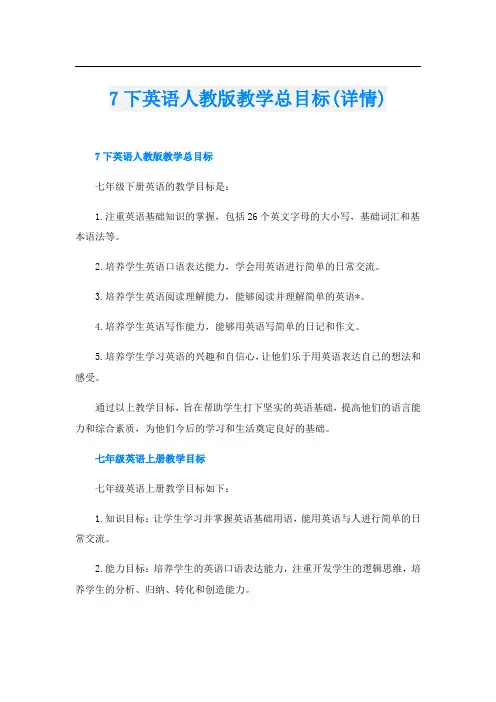
7下英语人教版教学总目标(详情)7下英语人教版教学总目标七年级下册英语的教学目标是:1.注重英语基础知识的掌握,包括26个英文字母的大小写,基础词汇和基本语法等。
2.培养学生英语口语表达能力,学会用英语进行简单的日常交流。
3.培养学生英语阅读理解能力,能够阅读并理解简单的英语*。
4.培养学生英语写作能力,能够用英语写简单的日记和作文。
5.培养学生学习英语的兴趣和自信心,让他们乐于用英语表达自己的想法和感受。
通过以上教学目标,旨在帮助学生打下坚实的英语基础,提高他们的语言能力和综合素质,为他们今后的学习和生活奠定良好的基础。
七年级英语上册教学目标七年级英语上册教学目标如下:1.知识目标:让学生学习并掌握英语基础用语,能用英语与人进行简单的日常交流。
2.能力目标:培养学生的英语口语表达能力,注重开发学生的逻辑思维,培养学生的分析、归纳、转化和创造能力。
3.情感目标:让学生了解中西方文化差异,拓宽国际视野,提高对中外文化异同的敏感度和鉴别能力,进而提高跨文化交际的能力。
4.德育目标:引导学生尊重理解多元文化,树立正确的人生观和价值观。
5.文化目标:让学生了解世界各地的文化特色,拓宽文化视野,培养跨文化交际的意识。
6.语言技能目标:通过听说读写的训练,学生能够灵活运用英语,具备在日常生活中用英语进行思维和表达的能力。
7.学习策略目标:培养学生自主学习和合作学习的能力,注重培养学生的思维能力和创新能力。
8.学科核心素养目标:培养学生良好的英语语言感知能力,提升他们的语言运用、思维能力、文化修养和自主学习能力。
9.发展目标:关注学生的终身发展,培养其英语综合素质和全面素质。
七年级英语上教学目标七年级英语上学期的教学目标可以包括:1.语言知识:学生应该掌握基本的英语语法结构,包括名词、代词、数词、动词、形容词等。
他们应该能够理解和使用这些语法结构,并能够进行简单的日常交流。
2.语言技能:学生应该具备听、说、读、写四项技能,并能够灵活运用这些技能。
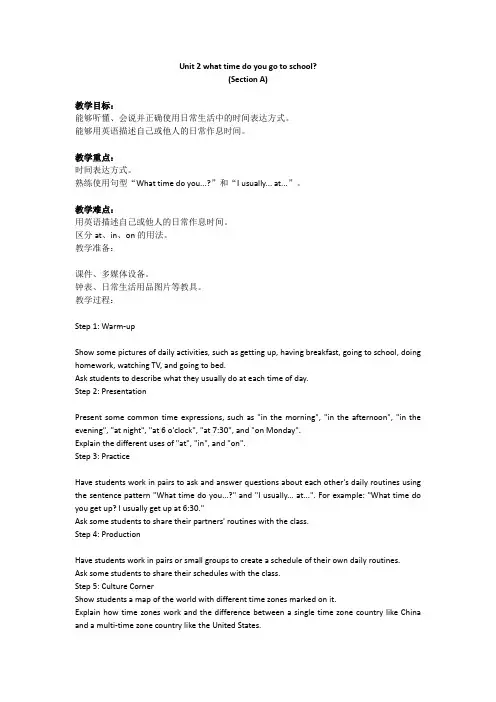
Unit 2 what time do you go to school?(Section A)教学目标:能够听懂、会说并正确使用日常生活中的时间表达方式。
能够用英语描述自己或他人的日常作息时间。
教学重点:时间表达方式。
熟练使用句型“What time do you...?”和“I usually... at...”。
教学难点:用英语描述自己或他人的日常作息时间。
区分at、in、on的用法。
教学准备:课件、多媒体设备。
钟表、日常生活用品图片等教具。
教学过程:Step 1: Warm-upShow some pictures of daily activities, such as getting up, having breakfast, going to school, doing homework, watching TV, and going to bed.Ask students to describe what they usually do at each time of day.Step 2: PresentationPresent some common time expressions, such as "in the morning", "in the afternoon", "in the evening", "at night", "at 6 o'clock", "at 7:30", and "on Monday".Explain the different uses of "at", "in", and "on".Step 3: PracticeHave students work in pairs to ask and answer questions about each other's daily routines using the sentence pattern "What time do you...?" and "I usually... at...". For example: "What time do you get up? I usually get up at 6:30."Ask some students to share their partners' routines with the class.Step 4: ProductionHave students work in pairs or small groups to create a schedule of their own daily routines.Ask some students to share their schedules with the class.Step 5: Culture CornerShow students a map of the world with different time zones marked on it.Explain how time zones work and the difference between a single time zone country like China and a multi-time zone country like the United States.Step 6: HomeworkAssign students to write a short paragraph about their own daily routines using the sentence pattern "I usually... at...".Encourage students to use the time expressions and sentence patterns they have learned in class.教学反思:本课重点介绍了日常生活中常用的时间表达方式和句型,通过让学生在实践中运用这些表达方式和句型,巩固了他们的学习成果。
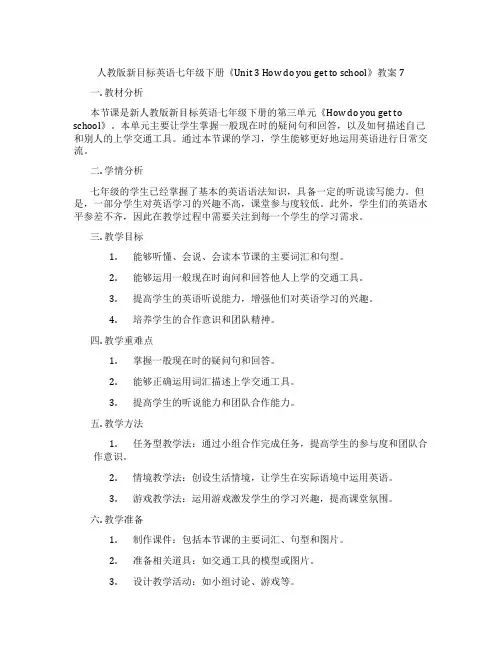
人教版新目标英语七年级下册《Unit 3 How do you get to school》教案7一. 教材分析本节课是新人教版新目标英语七年级下册的第三单元《How do you get to school》。
本单元主要让学生掌握一般现在时的疑问句和回答,以及如何描述自己和别人的上学交通工具。
通过本节课的学习,学生能够更好地运用英语进行日常交流。
二. 学情分析七年级的学生已经掌握了基本的英语语法知识,具备一定的听说读写能力。
但是,一部分学生对英语学习的兴趣不高,课堂参与度较低。
此外,学生们的英语水平参差不齐,因此在教学过程中需要关注到每一个学生的学习需求。
三. 教学目标1.能够听懂、会说、会读本节课的主要词汇和句型。
2.能够运用一般现在时询问和回答他人上学的交通工具。
3.提高学生的英语听说能力,增强他们对英语学习的兴趣。
4.培养学生的合作意识和团队精神。
四. 教学重难点1.掌握一般现在时的疑问句和回答。
2.能够正确运用词汇描述上学交通工具。
3.提高学生的听说能力和团队合作能力。
五. 教学方法1.任务型教学法:通过小组合作完成任务,提高学生的参与度和团队合作意识。
2.情境教学法:创设生活情境,让学生在实际语境中运用英语。
3.游戏教学法:运用游戏激发学生的学习兴趣,提高课堂氛围。
六. 教学准备1.制作课件:包括本节课的主要词汇、句型和图片。
2.准备相关道具:如交通工具的模型或图片。
3.设计教学活动:如小组讨论、游戏等。
七. 教学过程1.导入(5分钟)利用多媒体展示各种交通工具的图片,引导学生谈论自己上学的方式。
教师通过提问激发学生的兴趣,如:“How do you usually go to school?”学生回答后,教师简要介绍本节课的内容。
2.呈现(10分钟)教师展示本节课的主要词汇和句型,如:“I go to school by bus.”学生跟读并模仿,教师给予表扬和鼓励。
3.操练(10分钟)学生分组,每组选择一种交通工具,用英语描述自己的上学方式。
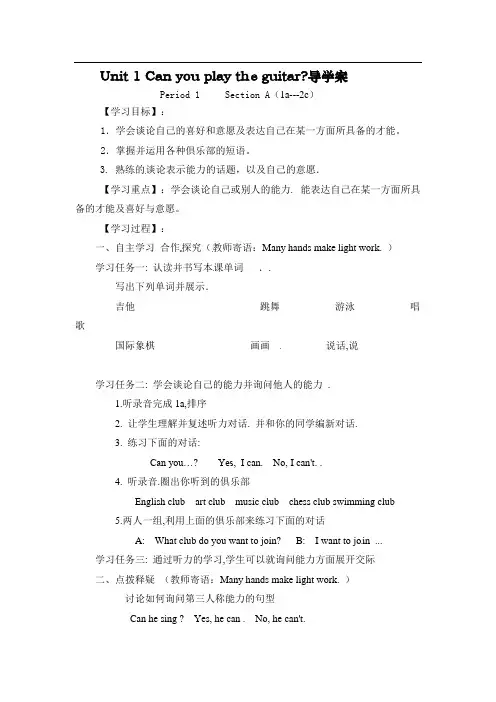
Unit 1 Can you play the guitar?导学案Period 1 Section A(1a---2c)【学习目标】:1.学会谈论自己的喜好和意愿及表达自己在某一方面所具备的才能。
2.掌握并运用各种俱乐部的短语。
3. 熟练的谈论表示能力的话题,以及自己的意愿.【学习重点】:学会谈论自己或别人的能力. 能表达自己在某一方面所具备的才能及喜好与意愿。
【学习过程】:一、自主学习合作探究(教师寄语:Many hands make light work. )学习任务一:认读并书写本课单词..写出下列单词并展示.吉他________________________ 跳舞__________ 游泳__________ 唱歌___________国际象棋__________________ 画画___________说话,说_______________学习任务二: 学会谈论自己的能力并询问他人的能力.1.听录音完成1a,排序2. 让学生理解并复述听力对话. 并和你的同学编新对话.3. 练习下面的对话:Can you…? Yes,I can. No, I can't. .4. 听录音.圈出你听到的俱乐部English club art club music club chess club swimming club5.两人一组,利用上面的俱乐部来练习下面的对话A: What club do you want to join? B: I want to join...学习任务三: 通过听力的学习,学生可以就询问能力方面展开交际二、点拨释疑(教师寄语:Many hands make light work. )讨论如何询问第三人称能力的句型Can he sing ? Yes, he can . No, he can't.Can Tom speak English? Yes,he can. No, he can't.What club does he want to join? He wants to join the chess club.三、盘点收获(教师寄语:No man can do two things at once.)总结一下在这节课中你所学的俱乐部的名称四、达标测试(教师寄语:Never do things by halves)(一)按要求写出下列单词或短语说英语_____________________________弹吉他_________________象棋俱乐部_____________________________(二)选择1.Can you ______English?A. speakB. talkC. sayD. tell2. Can he __________ basketball?A. playB. playsC. playingD. /3. My broth er want s ________ the chess club.A. joinB. to joinC. joinsD.join to(三)翻译下列句子1. 你会跳舞吗?是的,我会。

Unit 1 Can oue to choo in the morning--B bieod man goe to the e to choo -----______ m father’ carA B B In C With D For______ me near 3 hour ____ m homewor ever daA cot; to doB e neverUnit 3 How do ou get to choo?Section B 3a-Sef Chec【学习目标】1记住本课的18个单词和3个短语。
2熟练介绍各种地区的人们的交通方式。
3 熟练运用本单元短语、句型介绍交通方式。
【学习重点】谈论交通方式【学习过程】一、自主学习学习任务一:学习3a:1、检查单词的掌握情况。
2、读、理解短文,判断5个句子的正误,然后展示理解成果。
3、归纳、理解以下短语并学会运用。
全世界________________________ 乘校车上学____________________在世界的其他地区____________________在大城市________________更有趣得多____________ 最流行的做……的方式______________________乘船到校____________________ 不同于____________________学习任务二:学习3b:1、根据表格完成短文,然后看表格进行叙述。
2、归纳出表示数量的单词和短语绝大多数_______许多_______一些______ 少量的、很少的______________学习任务三:学习ote a viitor 3 We oo after each other4 We do the ver bet we can你还能加上几条?__________________________________________________【学习体会】Unit 4 D on’t eat in caSection B 1a— 1d ut…” , “ I have to…” , “ I can /can’t…”3、能听懂有关谈论规则的对话并进行自由交际。
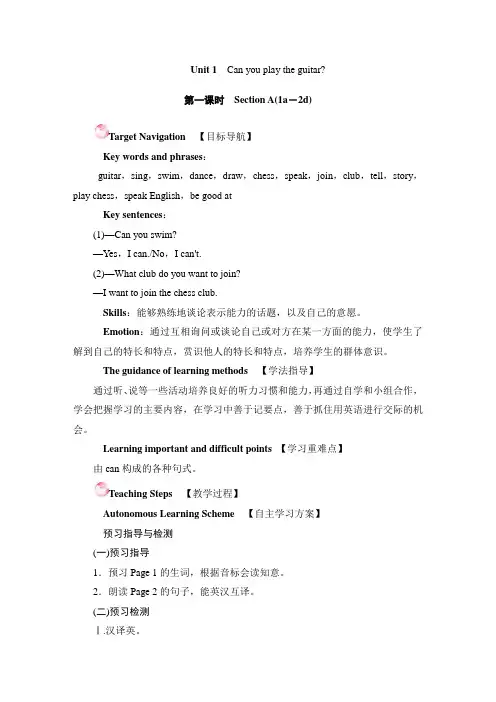
Unit 1Can you play the guitar?第一课时Section A(1a-2d)Target Navigation【目标导航】Key words and phrases:guitar,sing,swim,dance,draw,chess,speak,join,club,tell,story,play chess,speak English,be good atKey sentences:(1)—Can you swim?—Yes,I can./No,I can't.(2)—What club do you want to join?—I want to join the chess club.Skills:能够熟练地谈论表示能力的话题,以及自己的意愿。
Emotion:通过互相询问或谈论自己或对方在某一方面的能力,使学生了解到自己的特长和特点,赏识他人的特长和特点,培养学生的群体意识。
The guidance of learning methods【学法指导】通过听、说等一些活动培养良好的听力习惯和能力,再通过自学和小组合作,学会把握学习的主要内容,在学习中善于记要点,善于抓住用英语进行交际的机会。
Learning important and difficult points 【学习重难点】由can构成的各种句式。
Teaching Steps【教学过程】Autonomous Learning Scheme【自主学习方案】预习指导与检测(一)预习指导1.预习Page 1的生词,根据音标会读知意。
2.朗读Page 2的句子,能英汉互译。
(二)预习检测Ⅰ.汉译英。
1.吉他________ 2.唱歌________3.游泳________ 4.跳舞________5.画画________ 6.下国际象棋________7.讲英语________ 8.参加________9.音乐俱乐部____________10.艺术俱乐部____________11.游泳俱乐部____________(Keys:1.guitar,2.sing,3.swim,4.dance,5.draw,6.play chess,7.speak English,8.join,9.the music club,10.the art club,11.the swimming club)Ⅱ.完成书中第一页1a的练习。
七年级下册Unit 12 What did you do last weekend?写作教学案话题:假期活动(教师使用)【写作目标】用一般过去时态叙述假期活动。
【阅读积累】一、词汇积累:(课前任务)1、做作业2、去看电影3、打羽毛球4、弹吉它5、和朋友们一起吃晚饭6、在游泳池中游泳7、为测试而学习 8、在湖边扎营参考答案:1.do my homework 2.go to the cinema 3.play badminton 4.play the guitar 5.have dinner with friends 6.swim in a swimming pool 7.study for a test 8.camp by the lake二、句型积累:根据汉语意思完成下列句子。
(课前任务)1、我熬夜看足球赛了。
I _______ _______ ________to watch the soccer game.2、上个周末是有趣的但又是恐怖的。
Last weekend was _______ ________ ________.3、猴子开始上窜下跳。
The monkeys started to ______ _______ ________ ________.4、我爸爸今早六点叫醒了我,然后我们开始跑步。
My dad _______ me ________ at six this morning and then we ______ ________ _______.5、我们观看了消防人员工作。
他们拥有一份多么有趣的工作!We _______ the firefighters work. ________ an interesting job they have!参考答案:1.stayed up late 2. interesting but scary 3.jump up and down 4.woke up; started to run 5.watched;What三、写出与本话题有关的词汇和句型。
最新人教新目标七年级英语下册全英文教案(全册全英文)Unit 1 Can you play the guitar?教学过程♦ Step 4 Role-play1.Ask the students to read the conversation in 2d.try to find: What can Jane/ Bob do?What club do they want to join?2.Ask the students to fill in the forni.(见课件)3.Ask students to practice the conversation according to the for m・4.Ask students to perform the conversation.♦Step 5 Explain several important words and phrases.(见课件)♦Step 6 HomeworkMake a survey about what your friends can do and what club your friends want to join. 板书设计Unit 1 Can you play the guitar教学过程Example:In my group,Li Lin can do kung fii.Liu Kun can tell stories....Fm sure we will give you a good show and make you have a good time・♦ Step 6 HomeworkWrite an ad—Students Wanted for Our Learning Group・板书设计Unit 1 Can you play the guitar4.Ask students to read the passages in 2b.And then match the titles with the ads・5.Check the answers・6.Who fits the job? Match each person in 2a with an ad in 2b.Write A.B and C.(见・课件)7.Check the answers・♦Step 5 Explain important points.♦Step 6 HomeworkWrite a letter to your. teacher.Tell him/lier what you can do for school concert・板书设计课堂练习I •根据汉语意思完成句子1.你能帮我学英语吗?____ you help me ________ English?2.你善于和老人相处吗?____ you ______________ old people?Unit 1 Can you play the guitar(3)hclp⑷be good at/witli/for的用法与区分Work on Self Check 3Ask several students to show their works.♦ Step 5 HomeworkWrite a poster:Artist Wanted for Art Festival.板书设计课堂练习I •单项选择1 ・ Peter __ play soccer・A.can alsoB.also canC.can tooD.too can2.___ you good ______ c hildren?A.Are;forB.Is;in.C.Are;atD.Are;with3.Please call Mr.White ____ 589-267.A.inB.atC.onD.with4.― an you sing or swim?A.YesJ can swimB.NoJ can't swimC.YesJ can singD.I can sing5.___________________________ We want two good actors our school show.Unit 2 What time do you go to school?Keys:(l )From 12:00 at night to 6:00 in the morning. (2)At eight thirty at night. (3) At nine. (4) At ten twenty.(5) At elev亡n o'clock.3.Ask students to practice the conversation in 2d in pairs.教学过程板书设计课堂练习I .根据句意及首字母提示完成单词I・一What t _ da you go to school?—At &00.2.1usually get u ____ at 7:00 every day.What about you?3.__________________________________ My mother bought me two red d on my birthday.4.1need a new b _____ and some new pencils to draw the picture・5.1usually take a s ____ before I go to bed・Keys: 1.time 2.up 3.dresses 4.brush 5.showcrII.用所给词的适当形式填空1. A man has twenty-eight ______ (tooth)・2.Mrs.Li _____ (dress) little Tom every morning.3.My father ______ (work) in a shoe factory.4.Mr.Wang tells us a _____ (fun) story in class.5.1do morning ______ (exercise) with my grandparents every day.Unit 2 What time do you go to school♦Step 2 Learning Grammar Focus1.Ask students to read the sentences in Grammar Focus and translate them into Chinese.,2.Explain several important points・3.Ask students to do some exercises.(见课件)♦Step 3 Writing sentences1 .Work on 3a.Ask the students to write answers or e always,usually or never.2.Ask the students to show the answers.3.Let students write something they always/usually/never do on the blackboard・4.Ask students to do an interview with three students.Find out what time they do the activities in 3c.Then give a report. For example:In our group.Li Fei usually gets up late on weekends.She gets up at...♦Step 4 Explain several important words and phrases.(见课件)♦Step 6 HomeworkWrite an article to mtrodnee your classmate's daily activities.板书设计课堂练习I .根据句意及汉语提示写单词1 .This is a big train (火车)(站)・2.Lily ____ (从不)buys green clothes.3.You don't need to go to school ______ (早地)next Monday.4.The _____ (收音M) player is very nice・5.We have lunch at twelve _______ (点钟).Unit 2 What time do you go to school教学过程♦Step 4 Explain several important points.♦Step 5 HomeworkWrite a passage about your daily life.板书设计课堂练习I .单项选择I.Can you help us do _____ ?A.our homeworksB.our homework homeworks homework2.We go home at half _____ five ______ t he aftemoon.A.to;inB.past;atC.to;atD.past;in3.What time do you eat _____ breakfast? What do you usually have _______ breakfast?A./;/B.for;forC./;forD.for74.1 like to eat __ apples _____ pears.but not grapes・A.either;orB.neither;norC.not only;butD.or;or5.____________ The cake good.I w^nt another one・A.feelsB.tastesC.soundsD.feelsKeys:l—5BDCABII•根据汉语意思完成句子Unit 2 What time do you go to schoolUnit 3 How do you get to school教学过程♦ Step 4 Work on 2dStudent A is Jane and Student B is e the information in 2b to make conversations.A:How do you get to school?B:L・・A:How long does it take...?B:It takes...A:How far is it from...to...?Bit's about...♦Step 5 ReadingAsk students to read the dialogue in 2e and translate it into Chinese.Then ask students to role-play the dialogue. ♦Step 6 HomeworkPractice the conversation in 2c.板书设计课堂练习1.根据句意及汉语提示写单词1 Jim is not happy because he lost his _____ (自行车).2.There are always lots of people on the _____ (公共汽车).3.My aunt takes the ____ (地铁)to work every day.4.—How do you get to Beijing?—I take the ____ (火车).5.1 usually _____ (步行)to school in the morning・Keys: 1.bike 2.bus 3.subway 4.train 5.walkUnit 3 How do you get to school教学过程♦ Step 4 Make a survey 3cl.Show a chart on the screen.(2.Let students ask their classmates questions and write their names in the chart.The firs4 student to fill in all the blanks wins.3.Ask several students to show their results in front of the class・板书设计课堂练习I •单项选择l.____________ How far is from Hangzhou to Wuhan?A.thatB./C.itUnit 3 How do you get to school教学过程4.Check the answers.(见课件)①They go on a ropeway to cross the river to school.②Because they don't have a bridge over die Tiver.③Yes.he does.Because he loves to play with his classmates and he loves his teacher.④The dream is that there .is a bridge over the river.I think their dream can come true.Because all the villagers are working on it.5.Ask the students to read the passage again and complete the sentences in 2c with words from the passage・6.Check the answers・(l)difficult (2)big (3)quickly (4)afraid (5)truc♦ Step 5 HomeworkWrite a short passage about how your classmates go to school.板书设计课堂练习I •根据句意及首字母提示完成单词1.____________ Linda's h is far from her school.2.She t ____ the No.16 bus to school every day.Unit 3 How do you get to school2.F inish Self Check 2.Ask students to write at least five questions with the information in the chart.Then answer thequestions・For example:—How does Tony get to school?—He gets to school by bike・♦ Step 5 HomeworkWrite a passage with t he information in Self Check 2.板书设计课堂练习I•根据汉语意思完成句子1.Mike often _________________ (坐火车)to Beijing.2.Let's go there __________ (乘小汽车).3.My teacher ____________ (像)a friend to me.4.Mrs.Li has _________________ (—个八岁大的)daughter.5.1 eat fruit and vegetables ___________ (每天).6. _ ________ (多长时间)does it take Zhao Lei to do his homework?Keys: 1.takes the train 2.by car 3.is like 4.an eight-year old 5.cvcry day 6.How long II•根据句意,用合适的介词填空1 ・一What do you think _____ the travel?―reat.2.It is about two kilometers ____ my home _______ school.3.Thursday is ____ Wednesday and Friday.4.Jane often goes to school _____ t rain.5.___ many studentsat is easy to get to school. Keys: 1 .of 2.from;to 3.between 4.by 5.For教学反思Unit 4 Don't eat in class.教学过程2.Check the answers.(见课件)(1)It’s not to be late for class.We must be on time.(2)No.they can't.(3)No.they have to wear the school uniform.3.Let students role-play the conversation in 2d in pairs ♦ Step 6 HomeworkWrite the rules in your home.板书设计课堂练习I .根据句意及首字母提示完成单词I.It's very i __ for students to learn English well.2.We must be g _____ in the library.3.We can't eat ill the classroom but we can eat o _____ ・4.Doift a ____ late for class next time.5.Lily w _____ a red dress today.Keys: 1 .important 2.quiet 3.outside 4.arrive 5.wearsII.单项选择1.Don't be late ___ school.A.onB.forC.inD.at2.—Doni eat in the classroom.—__ ,Miss Liu.A.TlianksB.ReallyC.SorryD.Why3.We can't Jisten to music in the classroom. _____ we can do it in the hallways.A.andB.butC.soD.or4.― an I wear hats in class?—__ .but you can wear them after class・A.YesJ canB.Yes.you doC.NoJ can'tD.No,yon cant5.Rose _____ to school very early every day.A.arrivesB.getsC.reachesD.arriveKeys: 1—5 BCBDB教学反思Unit 4 Don,t eat inclass教学课题Section A (Grammar Focus-3c)教学目标【知识目标】Important phrases:wear a hat.wear a uniformImportant sentences:1 Don't run in die hallways.2.—What are the rules?—We must be on time for class・3.― an we eat in the classroom?—No,we can5t,but we can eat in the dinmg hall.4.—Docs he have to wear a uniform at school? ―Yes.he does./ No.he doesn't.5.—What do you have to do?—We have to be quiet in the library.教学重难点【能力目标】1.学会使用祈使句。
2023年新人教版七年级英语新目标下册
教学手册
目标
为七年级学生提供全面的英语教学手册
辅助教师进行教学准备和课堂教学
内容概述
本教学手册为新人教版七年级英语新目标下册的教学指南
包含教学大纲、课程安排、教学目标和教学资源等内容
旨在帮助学生有效研究英语,提高语言和沟通能力
主要特点
本教学手册注重培养学生的听、说、读、写能力
设计了多元化的教学活动,提升学生的研究兴趣和积极性
通过实时反馈和评估,帮助学生及时发现和纠正错误
使用方法
教师可根据教学手册的教学大纲进行每周课程的规划
教师可使用教学手册中的课程安排和教学目标,进行具体教学计划的制定
教师可根据学生的实际情况和研究进度,选择合适的教学资源和教学活动
注意事项
教师应根据学生的实际情况,合理调整教学内容和教学进度
教师应及时关注学生的研究情况,给予必要的帮助和指导
学生应按照教学手册的要求进行研究和作业完成
总结
2023年新人教版七年级英语新目标下册教学手册是一份全面的教学指南,旨在帮助学生提高英语能力和语言沟通能力。
教师可根据手册中的教学大纲和课程安排进行教学规划,从而有效组织课堂教学。
同时,教师还可以根据学生的学习情况适时调整教学内容和进度,以最大程度地提升学生的学习效果。
学生应按照手册要求进行学习和作业完成,积极参与教学活动,提高自己的英语水平。
七年级下册Unit 5 What do you like pandas?写作教学案(教师使用)【话题】动物园动物(Animals in a zoo)【写作目标】能运用本单元所学why ,what和where引导的特殊疑问句及语言材料,完成写作描述各种常见动物和表达自己对动物的喜爱。
【课前任务】一、写出下列短语。
1、有点2、南非3、许多4、其中之一5、处于危险中6、砍树7、迷路 8、由什么制成参考答案:1.kind of 2. South Africa 3. lots of 4.one of 5.be in danger 6.cute down 7. get lost 8. be made of二、根据汉语意思完成下列句子。
1、我的狗很聪明,它从来不会迷路。
My dog is very smart. It never _______ ________.2、海伦,别忘了给你叔叔回电话。
Helen, _______ _______ to call your uncle back.3、大卫是我最喜欢的歌手之一。
David is_______ _______ my favorite singers.4、请不要砍树。
Don’t _______ _______ trees ,please.5、这张桌子是木头做的。
The desk_______ _______ ________ wood.参考答案:1.gets lost; 2.don’t forget; 3. One of; 4.cut down; 5.is mad of三、写出与本话题有关的词汇和句型。
常用词汇:tiger, panda, lion, dog, cat, smart , cut , lazy, fun, interesting ,boring , beautiful, scary, friendly.经典句型:Why do you like…? Because they’re really cool.Where are lions from? They’re from…What animals do you like ? I like …【课中任务】读写结合一、A. 信息归纳阅读下面短文,然后按照项目要求填写所缺信息。
人教版新目标七年级下册英语全册教案初二第二学期全套教学设计人教版新目标七年级下册英语全册教案初二第二学期全套教学设计七年级英语第二卷unit1-10全册教案第1单元可以弹吉他吗?。
2单元2什么学校?。
11单元3你是怎么去学校的?。
19单元4茶点班。
25单元5为什么会这样?。
336单元我在看电视。
43单元7正在下雨!。
55单元8这里是办公室吗?。
659什么样的发型?。
74unit10i'dlikesomenoodles。
你的学校旅行怎么样?。
91Unit12上周末你做什么?。
一百零三2021年春七年级英语下册教案你能弹吉他吗?一.knowledgeandabilitiesgoals:词汇:跳舞、游泳、唱歌、下棋、画画、说英语、弹吉他。
Howtusemodel动词“can”。
contentofcourses:inthisperiod,studentswilllearnsomenamesofclubs,suchasart,musi c,chessclub,swimmingclub,etc.studentswilllearnthedrills:doyouwanttojoin…club? canyou…?四.importanceanddifficulty:can教学内容:AtaperRecorder。
一些照片。
例如排球、篮球等。
课前备考试卷。
五、授课时间:4个周期period1(sectiona:1a-2d)讲师:上课时间:2022年月日中午1.knowledgeobjects:learntotalkaboutabilities.了解一些关于文化俱乐部的知识。
你/他……能吗。
?你能做什么?你想加入什么俱乐部?会,不会,画画,跳舞,游泳,说话,走路。
2.教学重点:can3。
教学难点:can4。
教学程序:第一步。
引入enjoyasongi’mamusiciant:doyouwanttobeamusician?s:t:canyouplaythepiano?s…t:wh atc anyoudo?s:ican…t:whataboutyou?s:t:好的,现在请展示你的技能并告诉我们你能做什么。
人教版新目标七年级下册英语全册教案(新) 按住Ctrl键单击鼠标打开教学视频动画全册播放 Unit 1 Can you play the guitar?
重点 难点 I.复习词汇:can,play,want 2.词汇:guitar, dance, swim,sing, chess, speak, drum,trumpet,violin,play the guitar 3.句型:Can you/he/she/you dance? Yes,I/he/she/we can./No,I/he/she/we can’t. Can Bill play the guitar? Yes,he can,but he can’t sing. 语法重点:情态动词can的肯定句、否定句、一般疑问句及肯定与否
定回答、特殊疑问句的构成 Section A 教学内容
Section A(教材P59~61) 教学目标 知识与能力 Section A的主要内容是运用情态动词can “询问和谈论能力”;通过谈论自己在某一方面所具备的才能,学习情态动词Can的基本用法。 过程与方法 采用Classifying和Role—playing的学习策略,利用教学图片、幻灯片、实物(各种乐器)或制作课件(演奏各种乐器)等来展开课堂教学、Pairwork问答式的口语交际活动或小组活动,进行“询问和谈论能力”的课堂教学和练习、
情感态度价值观 Section A的学习内容贴近学生的生活,谈论的话题是能力。通过互相询问或谈论自己或对方在某一方面的能力,可以培养学生的一种群体意识。 教学重、难点及教学突破 重点 学习询问和谈论彼此的能力和特长; 语法难点 情态动词can的构成和使用。 教学突破 Section A重在通过使用情态动词can来询问和谈论能力,因此如何使用情态动词can就成了关键。教师可通过模仿、操练使学生掌握can的肯定句、否定句和疑问句的构成,再进行谈论能力的训练就容易多了。 教学准备 教学步骤 一、第一教学环节:情景创设,导入新课 教师活动 学生活动 Section A的主要内容是运用情态动词Can“询问和谈论能力”。在导入新课时,可采取演绎导人法和视听导入法。 1.出示一些反映各种活动的图片、幻灯片或播放课件,引导学生谈论活动: He/She can dance/swim/sing/"••But I can’t dance/swim/sing/...等,学习表达活动的动词短语。 2.教师可携带一些易于演奏的乐器,也可带一些演奏乐器的图片,一边演示乐器,一边说.I can play the guitar.…等;再指着图片说:He/She can play the violin.But I can’t play it.等;然后询问学生:Can you play the guitar?….并引导学生进行简单的回答。 3.出示1a部分的图片或幻灯片或播放该内容的课件,引导学生将活动与人物进行搭配,完成la部分的教学任务。 1.观看教师出示的反映各种活动的图片、幻灯片或课件,谈论其所反映的活动:He/She can dance/swim/sing/…But I can’t dance/swim/sing/...等,学习表达活动的动词短语。 2.观看教师的演示和谈论,仔细听讲,理解情态动词can的基本用法,回答教师的提问:Yes,I can./No, I can’t. 3.观看1a部分的图片或幻灯片或该内容的课件,将活动与人物进行搭配.完成la部分的学习任务。 二、第二教学环节:师生互动,学习探究 教师活动 学生活动 1.播放lb部分的录音让学生听,引导学生根据所听到的内容,选出对话的顺序,完成1b部分的教学任务。 2.引导学生展开Pairwork活动,完成lc部分口语交际的教学任务,学会运用can询问和表达能力。 3.播放2a部分的录音让学生听,引导学生圈出俱乐部的名称,完成2。部分的教学任务。 4.引导学生根据对话内容选择合适的单词填空,补全对话,再播放2。部分的第一个对话录音让学生进行校对。练习听力和写作能力,完成2b部分的教学任务。 5. 引导学生展开Groupwork活动,完成2c部分口语交际的教学任务。让学生先练习2b部分的对话,再根据图示改编对话并进行操练,运用What club do you want to join? I want to join…club.等目标语言。 6.引导学生将3a部分的对话整理成序,运用What can you do? I can…等目标语言,完成3a部分口语交际的教学任务。 7.引导学生展开调查活动,互相询问彼此的能力和特长并进行回答,然后向全班进行汇报,要求学生学会运用所学目标句型,完成3b部分的教学任务。 1.听1b部分的录音,根据所听到的内容,选出对话的顺序,完成1b部分的学习任务。
2.展开Pairwork活动,完成1c部分口语交际的学习任务,学会运用can询问和表达能力。 3.听2a部分的录音,然后根据录音内容圈出俱乐部的名称,完成2a部分的学习任务。 4.根据对话内容选择合适的单词填空,补全对话,再听2a部分的第一个对话录音进行校对,练习听力和写作能力,完成2b部分的学习任务。 5.展开Groupwork活动,完成2c部分口语交际的学习任务。先练习2b部分的对话,再根据图示改编对话并进行操练,运用What club do you want join? I want to join…club.等目标语言。 6.将3a部分的对话整理成序,运用What can you do? I can…等目标语言,完成3a部分口语交际的学习任务。 7.展开调查活动,互相询问彼此的能力和特长并进行回答,然后向全班进行汇报,要学会运用所学目标句型,完成3b部分的学习任务。
三、第三教学环节:合作交流,巩固提高 教师活动 学生活动 引导学生进行Job Interview小组活动,让学生在阅读广告之后向全班同学进行调查,询问谁能胜任所招聘的工作,练习运用所学目标语言,完成第4部分 的教学任务。 进行Job interview小组活动,在阅读告之后向全班同学进行调查,询问谁胜任所招聘的工作,练习运用所学目语言,完成第4部分的学习任务。
板书设计 Unit 1 Can you play the guitar? Section A 生词:guitar, dance, swim, sing, chess, speak, can’t, job, children, kid, summer, camp
重点句型:Can you swim/paint/sing? Yes, I can./No, I can’t. Can you/he/she/you dance?/ Yes, I /he/she/we can. No, I/he/she/we can’t. What club do you want to join? I want to join…club.
语法重点:情态动词can的肯定句、否定句和疑问句的构成。
问题探究与拓展活动 情态动词call的用法:情态动词can不能单独使用(简单回答除外),后须接动词原形才能表达完整含义。在变成疑问句时,要将其移至句首,在变成否定句时,只需在其后面加not。Can一般有两种含义:(1)表示能力,意思是“能;会”,如:I Can swim.我会游泳。I call play the guitar.我能弹吉他。(2)用在主语是第一人称的疑问句中,表示征求意见,意思是“可以”,同may的用法,如:Can I help you? 我能帮助你吗? Can/May I know your name?我可以知道你的名字吗? 练习设计 随堂练习设计 学校的各个特长俱乐部要招生。今天,有两个好朋友Mario和Lisa一起去参加面试,请完成下面主考老师与他们之间的对话 Teacher:(1) _________________________ Mario、Lisa:We want to join the music club. Teacher:(2) __________________________ Mario:I can sing. Teacher:(3)____________________________ Lisa:Yes,I Can also play the piano,but I can’t play it very well. Teacher:(4) ____________________________,Mario? Mario:Yes,l can also play the guitar. Teacher:(5)___________________________ Mario:Sorry,I can’t play it very well. KEY:1.What club d0 you want t0 join 2.What can you d0 3.Can you sing 4.Can you play the piano 5.Can you play it well 教学反思:
Section B
教学目标
知识与能力 Section B的主要内容:复习情态动词can用于“询问和谈论能力”的目标语言,掌握情态动词can的基本用法;能够运用所学目标语言表达自己在某一方面所具有的才能;能够为自己成立的各种俱乐部制作海报或招聘广告。 重点 学会运用情态动词can来询问和谈论自己的能力; 语法难点 情态动词can的构成和使用。 教学突破 Section B重在通过复习所学的“询问和谈论能力”的目标语言,学会谈论和表达自己或他人在某一方面所具备的能力和才艺,因此给学生提供一些施展才艺的舞台和机会,让他们在做中说、在说中做,既能培养他们的自信又能学会灵活运用所学内容。 教学准备